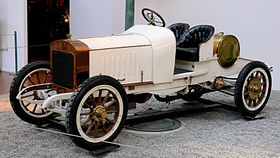De Dietrich Bugatti refers colloquially to a number of early automobile designs by Ettore Bugatti , known as the Types 2 through 7. Importantly, the vehicle known as the Type 2 of 1901 was designed by Bugatti before he joined the automobile manufacturer Lorraine-Dietrich in Niederbronn , Alsace, Germany following its successful reception. Types 3-7 were produced for De Dietrich between 1902 and 1904.
Type 2
Motor vehicle
The Type 2 was a prototype automobile designed and built by Ettore Bugatti in 1901 with financial support from a Count Gulinelli. It won an award at the Milan Trade Fair that year,[ 1] Adrien de Turckheim , managing director of the Lorraine-Dietrich automobile factory in Niederbronn in the then-German Alsace .
Motor vehicle
Bugatti Type 3 Manufacturer Lorraine-Dietrich Also called De Dietrich-Bugatti Production 1901-1904 Assembly Niederbronn-les-Bains Designer Ettore Bugatti Engine Type 3: 5,308 cubic centimetres (323.9 cu in; 5.308 L) Inline 4 Power output Type 3: 28 metric horsepower (28 bhp; 21 kW) Transmission 4-speed (Type 3 and 4) 3-speed (Type 5) Curb weight 1,000 kilograms (2,200 lb)
Types 3,4, and 5 were Bugatti's initial works for De Dietrich.[ 2] [ 3] [ 4] [ 5] [ 6] [ 7] [ 8] [ 9] [ 10] [ 11]
Type 6 and 7
Motor vehicle
Bugatti Type 6 Manufacturer Mathis Also called Mathis Hermes Simplex Production 1904-1907 Assembly Illkirch-Graffenstaden Designer Ettore Bugatti Engine 7,430 cubic centimetres (453 cu in; 7.43 L) Inline 4 Power output 50 brake horsepower (51 PS; 37 kW) Transmission 4-speed manual Wheelbase 2,930 millimetres (115 in) Length 4,150 millimetres (163 in) Width 1,540 millimetres (61 in) Curb weight 1,100 kilograms (2,400 lb) Successor Bugatti Type 8
Types 6 and7 were also designed by Bugatti while with De Dietrich through 1904. Approximately 100 Types 2-7 were produced from 1902 through 1904.[ 2]
See also
References






